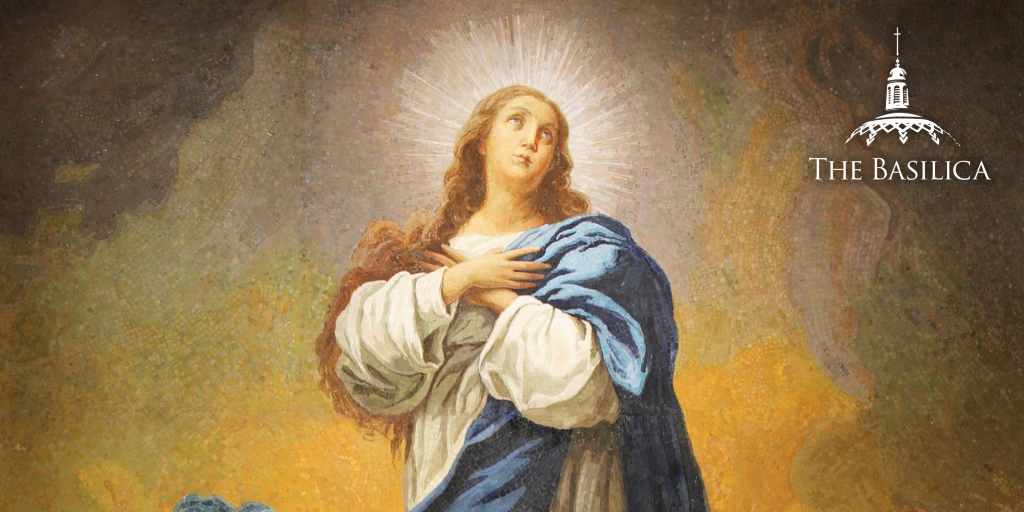

An ancient Catholic prayer dating to the fourth century praises the incomparable beauty of the Blessed Virgin Mary with the words, “Tota pulchra es, Maria.” Meaning “You are most beautiful, Mary,” this antiphon is prayed by the Church during Second Vespers for the Marian Feast of the Immaculate Conception. As the Church has always praised the Virgin Mary as the most beautiful of all creatures, it’s no wonder that her person, faith, and life have inspired countless artists through the ages. In paint, sculpture, mosaic, stained glass, and literature, the spiritual and moral beauty of the graced woman praised as the “most beautiful” has taken the form of the beautiful in sacred art, architecture, and music.
The Basilica of the National Shrine of the Immaculate Conception embodies the spiritual beauty of Mary in the beauty of its magnificent art and architecture. Here, a pilgrim journeys with the Virgin Mother of God in the rich variety of her appearances and cultural representations. A pilgrim is led from Mary’s Immaculate Conception, her birth and presentation in the temple, the Annunciation and birth of her divine son Jesus, her unique journey with His life, miracles, passion, death, and resurrection, to her glorious Assumption and crowning as Queen of Heaven. Since Mary’s life is bound intimately with the life of her divine son Jesus, this Marian journey is a Christ-centered pilgrimage.
Marian Beauty as Captured in the Immaculate Conception Mosaic

In this reflection, I invite you to contemplate one of the most sublime works of art in the Basilica, the large mosaic of the Immaculate Conception near the sanctuary of the Great Upper Church. Treasured as a papal gift from Pope Benedict XV and Pope Pius XI, the Immaculate Conception mosaic was created by the Vatican Mosaic Studio over five years. Composed of 250,000 pieces of naturally colored stones, the mosaic was sanded to give the effect of a smooth surface of a painting. Its inspiration was the exquisite oil painting, La Purísima Bionda, by the renowned 17th century Spanish painter, Bartolomé Esteban Murillo. At the time, devotion to the mystery of Mary’s sinless conception in the womb of her mother, Saint Anne, was widespread and popular in Spain. That devotion preceded the Church’s formal definition of the dogma of the Immaculate Conception on December 8, 1854.
In his lifetime, Murillo painted close to two dozen images of the Immaculate Conception, and the Basilica’s mosaic follows the artist’s typical depictions. We see the Virgin Mary dressed in an ethereal flowing white robe wrapped with a blue mantle that gently swirls about her. Her hands are crossed in a gesture of prayer and her eyes are raised to heaven. She appears to move while standing in a contrapposto posture, her right knee slightly bent and her left leg bearing the weight of her delicate frame. A fragment of a crescent moon, evoking a passage from the Book of Revelation, appears under her feet, hidden by enfolding layers of her white garment. Below, a group of cherubs carry her upward in a swirl of clouds that creates a sense of dramatic movement, and warm golden light radiates from her pure body as rays of holy light shine from her head. Yet it is the lovely, serene face of Mary that best evokes her incomparable spiritual beauty as the sinless Mother of God, praised by the Church as “tota pulchra es.”
It was the poet Dante who contemplated the Virgin Mary among the brilliant splendors of Paradise as, “beauty that was joy in the eyes of all the other saints” (Paradiso XXXI, 134-135). This masterpiece mosaic, and the numerous Marian images of the Basilica, invite us to join the Church and the Communion of Saints in contemplating the spiritual beauty of the faith and life of the Blessed Virgin Mary, Mother of God, Mother of the Church, and our mother in faith.
 About Dr. Jem Sullivan
About Dr. Jem Sullivan
Dr. Jem Sullivan, Ph.D. is associate professor in the School of Theology and Religious Studies at The Catholic University of America, Washington, D.C. She is an appointed member of the International Council for Catechesis in the Vatican’s Dicastery for Evangelization in Rome. Over three decades, she has served the Church at the national and diocesan levels, and has taught seminarians, undergraduate and graduate students. Dr. Sullivan is the author of four books including The Beauty of Faith: Christian Art and the Good News and Believe, Celebrate, Live, Pray: A Weekly Retreat with the Catechism. She writes art essays for Magnificat and is a guest commentator for USCCB’s Scripture reflections. Jem has hosted two EWTN television documentaries on the arts and evangelization, and used to serve as a volunteer docent at the National Gallery of Art, Washington, D.C., where she led tours of the museum’s masterpiece collections. Jem resides in Maryland with her family and is a parishioner at Saint Mark’s Catholic Church.
You can read more from Dr. Jem Sullivan in her new book, Way of Beauty, now available at the National Shrine Shops.
Learn more.


